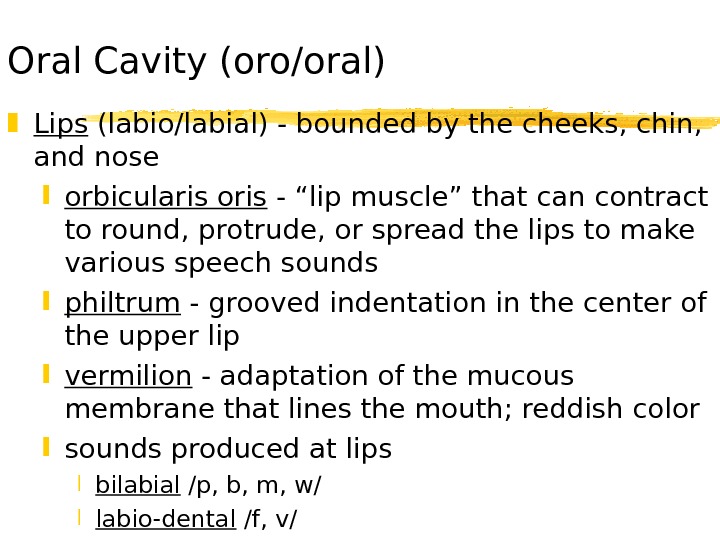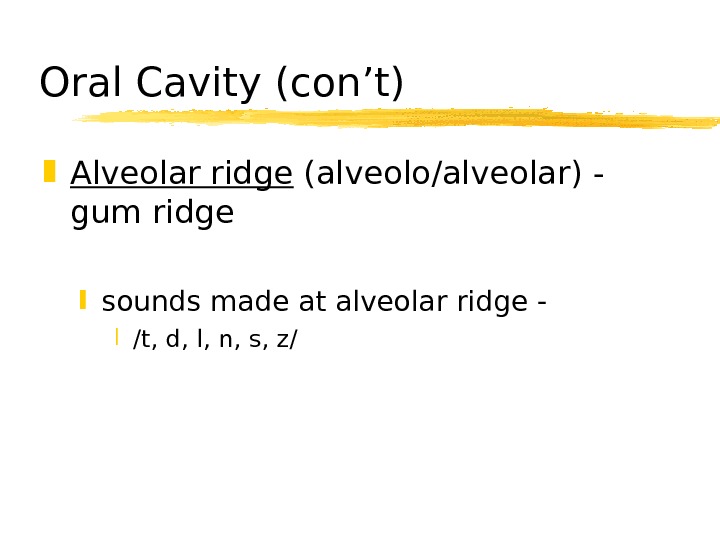The Speech Mechanism Speech is an overlaid



















- Размер: 76 Кб
- Количество слайдов: 18
Описание презентации The Speech Mechanism Speech is an overlaid по слайдам
 The Speech Mechanism Speech is an overlaid function there are no organs whose primary function is to produce speech Articulators — parts of the speech mechanism that serve to produce different configuartions which make up different sounds
The Speech Mechanism Speech is an overlaid function there are no organs whose primary function is to produce speech Articulators — parts of the speech mechanism that serve to produce different configuartions which make up different sounds
 Four Parts of the Speech Mechanism Oral Cavity Nasal Cavity Pharynx Larynx
Four Parts of the Speech Mechanism Oral Cavity Nasal Cavity Pharynx Larynx
 Oral Cavity (oro/oral) Lips (labio/labial) — bounded by the cheeks, chin, and nose orbicularis oris — “lip muscle” that can contract to round, protrude, or spread the lips to make various speech sounds philtrum — grooved indentation in the center of the upper lip vermilion — adaptation of the mucous membrane that lines the mouth; reddish color sounds produced at lips bilabial /p, b, m, w/ labio-dental /f, v/
Oral Cavity (oro/oral) Lips (labio/labial) — bounded by the cheeks, chin, and nose orbicularis oris — “lip muscle” that can contract to round, protrude, or spread the lips to make various speech sounds philtrum — grooved indentation in the center of the upper lip vermilion — adaptation of the mucous membrane that lines the mouth; reddish color sounds produced at lips bilabial /p, b, m, w/ labio-dental /f, v/
 Oral Cavity (con’t) Teeth (dento/dental)- important for sounds involving “lip & teeth” and “tongue & teeth” labio-dental sounds /f, v/ (“lip + teeth”) lingua-dental sounds / , / (“tongue + teeth”) Dental occlusion — how the teeth fit together when you bite down abnormal bite is a “ malocclusion ” neutrocclusion (normal jaw relationship) distocclusion (retruded mandible) mesiocclusion (protruded mandible)
Oral Cavity (con’t) Teeth (dento/dental)- important for sounds involving “lip & teeth” and “tongue & teeth” labio-dental sounds /f, v/ (“lip + teeth”) lingua-dental sounds / , / (“tongue + teeth”) Dental occlusion — how the teeth fit together when you bite down abnormal bite is a “ malocclusion ” neutrocclusion (normal jaw relationship) distocclusion (retruded mandible) mesiocclusion (protruded mandible)
 Oral Cavity (con’t) Alveolar ridge (alveolo/alveolar) — gum ridge sounds made at alveolar ridge — /t, d, l, n, s, z/
Oral Cavity (con’t) Alveolar ridge (alveolo/alveolar) — gum ridge sounds made at alveolar ridge — /t, d, l, n, s, z/
 Oral Cavity (con’t) Hard palate (palato/palatal) — anterior roof of mouth bone covered with membrane sounds made at hard palate /t , d , j, , /
Oral Cavity (con’t) Hard palate (palato/palatal) — anterior roof of mouth bone covered with membrane sounds made at hard palate /t , d , j, , /
 Oral Cavity (con’t) Velum (velo/velar) — soft palate movable fold of mucuous membrane that is continous with hard palate divides oral cavity from nasal for non-nasal sounds —> is LOWERED for nasal sounds made at velum — /k, g, / uvula — “little grape” serves little function in humans
Oral Cavity (con’t) Velum (velo/velar) — soft palate movable fold of mucuous membrane that is continous with hard palate divides oral cavity from nasal for non-nasal sounds —> is LOWERED for nasal sounds made at velum — /k, g, / uvula — “little grape” serves little function in humans
 Oral Cavity (con’t) Tongue (lingua/lingual) — most important of the articulators muscular organ capable of intrinsic (finer shapes) and extrinsic movements (responsible for up/down; backward/forward) divided into parts: tip front or blade — beneath alveolar ridge middle — beneath hard palate back — beneath velum root — most posterior part of tongue
Oral Cavity (con’t) Tongue (lingua/lingual) — most important of the articulators muscular organ capable of intrinsic (finer shapes) and extrinsic movements (responsible for up/down; backward/forward) divided into parts: tip front or blade — beneath alveolar ridge middle — beneath hard palate back — beneath velum root — most posterior part of tongue
 Oral Cavity (con’t) Mandible (mandibulo/mandibular) — lower jaw regulates the size of opening beneath teeth tongue is connected to mandible by the lingual frenum which attaches tip and blade of tongue to floor of mouth
Oral Cavity (con’t) Mandible (mandibulo/mandibular) — lower jaw regulates the size of opening beneath teeth tongue is connected to mandible by the lingual frenum which attaches tip and blade of tongue to floor of mouth
 Oral Cavity (con’t) Facial muscles — important in controlling cheeks and size of mouth aids in building intra-oral breath pressure
Oral Cavity (con’t) Facial muscles — important in controlling cheeks and size of mouth aids in building intra-oral breath pressure
 Nasal Cavity (naso/nasal) Extends from the nostrils (nares) to pharynx (throat) important in resonance by opening or closing of velopharyngeal port velopharyngeal valve or port is formed by the soft palate making contact with the pharyngeal wall must be closed for vowels and non-nasal consonants
Nasal Cavity (naso/nasal) Extends from the nostrils (nares) to pharynx (throat) important in resonance by opening or closing of velopharyngeal port velopharyngeal valve or port is formed by the soft palate making contact with the pharyngeal wall must be closed for vowels and non-nasal consonants
 Pharynx (pharyngo/pharyngeal) Throat extends from the posterior portion of the nasal cavity downward through the back of the oral cavity to the larynx pharynx is a vertical tube with 3 parts
Pharynx (pharyngo/pharyngeal) Throat extends from the posterior portion of the nasal cavity downward through the back of the oral cavity to the larynx pharynx is a vertical tube with 3 parts
 Pharynx (con’t) Nasopharynx — continuation of the nasal cavity uppermost part of pharynx; directly behind nasal cavity nasopharynx can be closed off from the oropharynx where they join at the velopharyngeal port Oropharynx — continuation of the oral cavity opens to mouth very versatile in assuming a variety of configurations Laryngopharynx — area just above larynx vibrating mechanism that houses the vocal folds sits on top of trachea
Pharynx (con’t) Nasopharynx — continuation of the nasal cavity uppermost part of pharynx; directly behind nasal cavity nasopharynx can be closed off from the oropharynx where they join at the velopharyngeal port Oropharynx — continuation of the oral cavity opens to mouth very versatile in assuming a variety of configurations Laryngopharynx — area just above larynx vibrating mechanism that houses the vocal folds sits on top of trachea
 Larynx Two purposes of larynx Prevent food from going into trachea epiglottis — leaf-like cartilage below root of tongue and at junction of oropharynx and laryngopharynx covers glottis during eating and drinking to prevent food and liquids from going into lungs Create a constriction in vocal tract which produces a sound source for communication
Larynx Two purposes of larynx Prevent food from going into trachea epiglottis — leaf-like cartilage below root of tongue and at junction of oropharynx and laryngopharynx covers glottis during eating and drinking to prevent food and liquids from going into lungs Create a constriction in vocal tract which produces a sound source for communication
 Anatomy of Larynx cricoid cartilage — bottom ring of larynx that sits on top of trachea looks like a signet ring artynoid cartilages — mobile, paired, pyramid-shaped cartilages that sit on top of cricoid cartilage they attach to the vocal folds so that movement of the arytenoid cartilages moves the vocal folds
Anatomy of Larynx cricoid cartilage — bottom ring of larynx that sits on top of trachea looks like a signet ring artynoid cartilages — mobile, paired, pyramid-shaped cartilages that sit on top of cricoid cartilage they attach to the vocal folds so that movement of the arytenoid cartilages moves the vocal folds
 Anatomy of Larynx (con’t) thyroid cartilage — largest structure of larynx shield-shaped cartilage that protects vocal folds referred to as “Adam’s apple” hyoid bone — only bone in body not connected to other bones attached to muscles and ligaments involved in swallowing and phonation is a horse-shoe or “U”-shaped bone just above thyroid cartilage
Anatomy of Larynx (con’t) thyroid cartilage — largest structure of larynx shield-shaped cartilage that protects vocal folds referred to as “Adam’s apple” hyoid bone — only bone in body not connected to other bones attached to muscles and ligaments involved in swallowing and phonation is a horse-shoe or “U”-shaped bone just above thyroid cartilage
 Anatomy of Larynx (con’t) Vocal folds — mucous membranes that attach separately to the arytenoid cartilages in back of larynx and come together in front at angle of thyroid cartilage Positions of vocal folds open (abducted) — for normal inhalation/ exhalation closed (adducted) — for phonation
Anatomy of Larynx (con’t) Vocal folds — mucous membranes that attach separately to the arytenoid cartilages in back of larynx and come together in front at angle of thyroid cartilage Positions of vocal folds open (abducted) — for normal inhalation/ exhalation closed (adducted) — for phonation
 Anatomy of Larynx (con’t) Glottis — opening in the vocal folds two sounds produced at level of glottis /h, / vocal folds vibrate to produce voicing middle of vocal folds vibrate to produce voicing
Anatomy of Larynx (con’t) Glottis — opening in the vocal folds two sounds produced at level of glottis /h, / vocal folds vibrate to produce voicing middle of vocal folds vibrate to produce voicing

